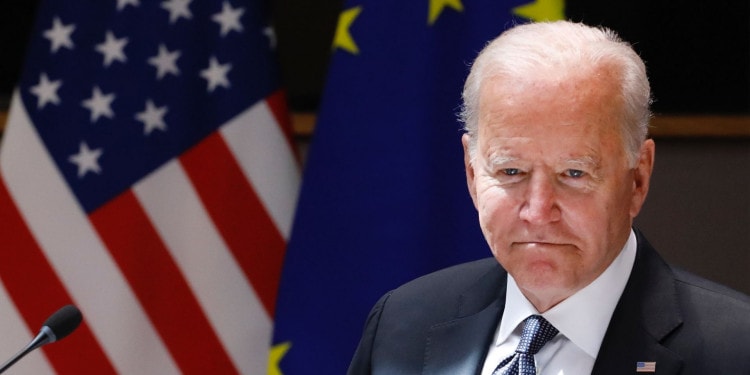President Biden significantly chose Europe as his first trip abroad. As he boarded the plane to attend the G7 Summit in the U.K., he announced that “the U.S. is back”. And that is in fact the biggest result of his “week of summits”. The week began on Thursday 10 June with Prime Minister Boris Johnson, a 90-minute meeting that resulted in reconfirmation of the “special relationship”, a term first used by Winston Churchill in a 1946 speech and a feature of US-UK relations since then.
Beyond a series of memorable photo ops, the Biden trip produced results that were often not in line with what the public expected. Notably, the hype around his meeting with Putin at the close of his trip was intense while the results were thin. By contrast, little attention was paid to the EU-US Summit, yet that meeting was, in many ways, the most notable one, with more concrete “key deliverables” than any of the other two summits, the G7 and NATO.
The EU-US Summit was arguably a “historic” event, as European Commission President Ursula von der Leyen put it, marking the acknowledgment by a U.S. President that the EU – a regional group that is still mostly an economic union though it has federal ambitions – is in fact a major partner and ally of the United States.
Here’s a breakdown of what was achieved and what we can look forward to in the future. Because, in a very real way, what President Biden has done – and done very successfully – is lay down the groundwork to build back up the kind of strong relationship the U.S. had always maintained with its European allies since the war and that Trump had destroyed. And at the same time, he has left no doubt in anyone’s mind as to who America’s biggest adversary is: China.
US-UK Special Relationship: Coming Together on China

Meeting ahead of the G7 Summit, the two leaders announced that they had signed a new “Atlantic Charter” pledging US-UK cooperation to address global challenges including cybersecurity, global health, and climate change.
Journalists had expected that Biden, given his Irish-catholic heritage, would raise the Northern Ireland question, but he didn’t. Instead, what happened was that Biden and Johnson came together on China, an “obsession” in Washington and a priority for Biden. As luck would have it, the time was ripe for a UK-US understanding on China. A major UK government report had just out in March, Global Britain in a Competitive Age, the Integrated Review of Security, Defence, Development and Foreign Policy set a new course for UK foreign relations, with countering China as a major objective. Thus, the UK will “tilt to the Indo-Pacific”, the report said, and in April, the government announced it would send to the Indo-Pacific its biggest Royal Navy fleet deployment since the 1982 Falklands War.
As early as March, Biden had discussed with Johnson one of his pet projects, the need for democratic countries to develop an alternative to China’s Belt and Road international infrastructure project. It is significant that at the time, he chose to talk to Johnson rather than an EU leader, and the explanation is simple: The EU Commission had announced in December 2020 an “EU-China Comprehensive Agreement on Investment” (CAI) that had riled Washington. German Chancellor Angela Merkel was the deal’s key architect with the support of French President Emmanuel Macron. CAI responded to a perceived widespread business interest in China, as German, French, and Italian manufacturers tend to see China as a lucrative export market. Moreover, China had already set a foot in the European door with its Belt and Road initiative notably in Greece (rebuilding and running the Piraeus port) and Italy (with a 2019 investment agreement).
But time (and Chinese faux-pas) was working on Biden’s side. On May 20, 2021, the European Parliament passed a resolution to freeze the ratification of CAI in response to Chinese sanctions on European human rights advocates that included several Members of the European Parliament and European researchers specializing in China.
A G7 Summit in the Shadow of China: Small Steps in the “Right Direction”
The G7 Summit rightly dealt with all the major issues – public health, climate change, human rights, recovery from the pandemic – but not always as expected. The final communiqué left many people unhappy.
On public health, the G7 took several steps forward. Regarding Covid vaccines, Biden called the shots early by offering 500 million doses – all going to COVAX. Over 90 poorer countries are expected to benefit, many in Africa. The offer was matched by the six other G7 leaders bringing the total to over one billion doses – but while these are steps in the right direction, one billion doses are clearly insufficient to protect the total world population that is multiples of that figure.
In terms of getting the world ready for the next pandemic, here too major steps were taken, in particular, there was a welcome reference to the need to use a One Health approach, the only logical way to deal with pandemics that often originate in the animal world.
So that was a step in the right direction but not enough unless rich countries pull their institutional act together and put money behind it, both to base the work of their own medical community on One Health and help developing countries to adopt it. We will see at the coming G20 meeting in Rome in October 2021 whether the world’s global politically important leaders, China and India included, can “join in concert to make One Health a real part of doing common cause.” Only then shall we be able to say “a new dawn has begun”.
On finance, there was progress on two fronts:
- Towards a global deal that would put a 15% floor under the tax paid by the world’s largest corporations, and in particular tech firms such as Amazon, Google and Facebook – though not the 21% advocated by Biden (but he was persuaded that it wasn’t realistic considering that countries like Ireland and Cyprus would be required to raise their rates from their current low 12.5%);
- Towards “building back better” after the pandemic and abandoning austerity policies, with broad recognition that economies needed longer-lasting and more generous stimulus programmes to recover;
There was also an effort to help reduce the borrowing costs of vulnerable countries to help them cover pandemic costs and boost their reserves by allowing them to have a $100 billion increase in the special drawing rights (SDRs) issued by the International Monetary Fund (IMF). That came up short of South African president, Cyril Ramaphosa’s request for $162 billion while anti-poverty groups said the G7 had failed to spell out the terms of the SDRs.
On climate change, Biden (unlike Trump) pushed for strong climate action. Climate activists were not satisfied, in fact, they were incensed that the G7 stopped short of adopting an expiration date for burning coal, a major cause of global warming.
But the G7 did agree to stop by 2022 international funding for any coal project that lacked the technology to capture and store carbon dioxide emissions. And there were other important steps taken in the right direction:
- It was the first time that major industrialized countries primarily responsible for climate change agreed to cut collective emissions by half over the next 9 years, by 2030.
- And it was the first time they tried to address the 6th extinction, i.e. the rapid extinction of animals and plants, calling it an “equally important existential threat”.
- Instead of coal, they focused on electricity and vowed to achieve an “overwhelmingly decarbonized” electricity sector by the end of the decade, promoting the uptake of zero-emission vehicles.
The G7 reconfirmed the promise to release $100 billion annually in support of developing world efforts to cope with climate change transitions. This however left poor countries disappointed that there was “no new money” on the table for them.
Biden obtained broad-ranging support on “countering” China, from criticizing Beijing over human rights in its Xinjiang region (the Uighur question) and committing to cooperation to remove forced labor from supply chains; calling for Hong Kong to keep a high degree of autonomy; demanding a full investigation – “timely, transparent, expert-led and science-based” – of the origins of the coronavirus in China; and supporting Taiwan.
But for Biden, perhaps what was most important was to get the G7 to support the project he had discussed with Johnson, a global “green” infrastructure scheme that would “address strategic competition from China” and act as a “higher quality” alternative to China’s massive international infrastructure investment scheme, known as the Belt and Road Initiative (BRI). And that meant, inter alia, overcoming Italy’s reluctance since it had signed on a BRI agreement in 2019. But the European Parliament’s freezing of CAI came to Biden’s rescue.
Proposed by the White House and called the Build Back Better World (B3W) initiative, the idea is to mobilize private-sector capital in areas such as climate, public health, digital technology, and gender equity and equality. US officials said the plan would involve raising hundreds of billions in public and private money to help close a $40tn infrastructure gap in needy countries by 2035.
Many hundreds of billions will be indeed needed to rival China’s BRI. According to a Refinitiv database, BRI involves more than 2,600 projects in over 100 countries, with a value of $3.7 trillion linked to the initiative as of the middle of 2020 – although, according to the Chinese foreign ministry, as of last June, about 20% of projects had been seriously affected by the Covid pandemic.
Also, as recently pointed out by the EU foreign affairs chief Josep Borrell, China’s assistance consists of loans, which, as is well-documented, can push countries into devastating debt while yielding few or no results. By contrast, the EU’s development assistance – some €414 billion between 2013 and 2018 – was provided in grants. This made it broadly comparable with what China offers, and with none of the financial risks and other problems arising from loans:
Unsurprisingly, while generally praised for its timing and principles, the B3W initiative was criticized for falling short on concrete details, even of being a “half-baked scheme”. Much will depend on whether Congress follows through in supporting Biden on this project.
NATO Summit: For the First-time China is Mentioned
Here too, Biden pursued his China agenda with success. At his urging, the communiqué from the NATO meeting in Brussels used a language that was stronger than the G7, saying that China’s “stated ambitions and assertive behaviour present systemic challenges to the rules-based international order”. Other issues raised included concerns about China’s “coercive policies” (a clear reference to the repression of the Uyghur Muslims in Xinjiang), the expansion of its nuclear arsenal and its “frequent lack of transparency and use of disinformation”.
What is remarkable about this communiqué is that it’s the first time ever that such a mention of China is made since NATO was founded. After all, it was founded in 1949 as a transatlantic military alliance to counter the Soviet Union, not China.
Boris Johnson was quick to remark that nobody wanted a “new cold war”. French President Emmanuel Macron quipped “In my book, China isn’t part of the Atlantic geography, or maybe my map has a problem.”
EU-US Summit: The Most Constructive Meeting
I’ve written extensively about it in a previous article, and here I will only point to what can be expected from the “key deliverables” in the future.
The main achievement is the Brussels-Washington united front after years of acrimony. Notably, a 5-year truce on the Airbus-Boeing dispute was agreed on, although the door remains open for renewed punitive trade sanctions if either side does not live up to the deal. Yet the time span chosen is interesting: Five years, going thus beyond Biden’s mandate. Should Trump come back, or someone like him, it won’t be all that easy to undo the cooperation achieved.
Washington and Brussels went down to specifics, promising to cooperate on digital standards at the World Trade Organization and to coordinate approaches on semiconductor manufacturing. However, longstanding differences, especially with regard to how each side approaches digital policymaking, remain.
The EU-US cooperation is based on the creation of ten working groups to cover all areas of common interest, from how artificial intelligence rules should be created globally to the establishment of joint positions on protecting emerging technologies from authoritarian governments, something of increasing importance for Europe.
Among them, the most important is undoubtedly the EU-US Trade and Technology Council with a series of goals:
- Expand and deepen bilateral trade and investment
- Avoid new technical barriers to trade
- Cooperate on key policies on technology, digital issues and supply chains
- Support collaborative research
- Cooperate on the development of compatible and international standards
- Facilitate cooperation on regulatory policy and enforcement
- Promote innovation and leadership by EU and US firms
On the question of China, the EU’s all-inclusive formula developed over the last two years, “cooperation, competition and rivalry” meant to define relations with China, found its way in the EU-US summit joint statement, no doubt to Biden’s satisfaction.
Biden-Putin Summit: The Most Hyped, Few Concrete Results
This was the meeting that got the most attention, particularly as Biden had notoriously called Putin a “killer”. It ended with not much more than a joint statement on strategic stability in which the two reaffirmed the Reagan-Gorbachev principle “that a nuclear war cannot be won and must never be fought” and an agreement to send each other’s ambassadors back to their post.
The highpoint in the three-hour meeting appears to have been a discussion over cyberattacks, with Putin predictably denying that they came from Russia and with Biden warning the US would retaliate if needed. In fact, a whole range of issues came up, including human rights, but it was clear, as the New York Times noted, that they remained profoundly divided.
In fact, Biden himself did not appear to expect much more than setting some “rules of the road” in a relationship that has been eroding for years, with the abandonment of all arms control agreements but one. And no doubt that is what he got: A re-opening of communication channels at the diplomatic level. Something important in his ongoing quest to counter China, considering the close relationship Russia maintains with China. A relationship that China was quick to define as an “unbreakable friendship” with Moscow, saying that would be there to stay.
So yes, US-China rivalry is bound to impact the rest of this century. And Biden knows it.
Editor’s Note: The opinions expressed here by Impakter.com columnists are their own, not those of Impakter.com — In the Featured Photo: EU-US Summit roundtable (plenary session): Joseph BIDEN (President of the United States of America) Source: EU Council Newsroom














